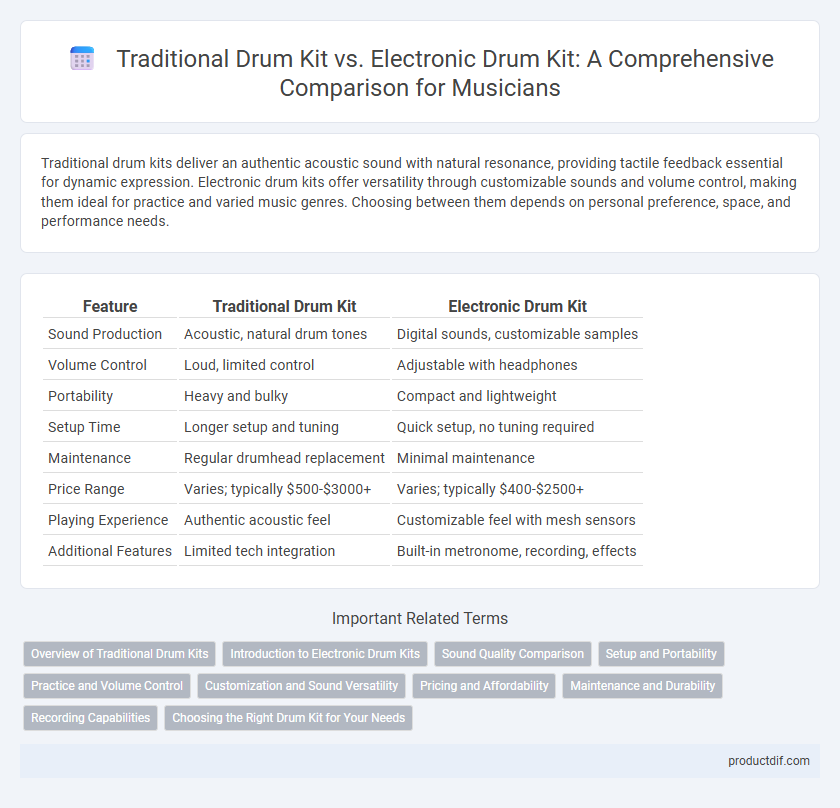Traditional drum kits deliver an authentic acoustic sound with natural resonance, providing tactile feedback essential for dynamic expression. Electronic drum kits offer versatility through customizable sounds and volume control, making them ideal for practice and varied music genres. Choosing between them depends on personal preference, space, and performance needs.
Table of Comparison
| Feature | Traditional Drum Kit | Electronic Drum Kit |
|---|---|---|
| Sound Production | Acoustic, natural drum tones | Digital sounds, customizable samples |
| Volume Control | Loud, limited control | Adjustable with headphones |
| Portability | Heavy and bulky | Compact and lightweight |
| Setup Time | Longer setup and tuning | Quick setup, no tuning required |
| Maintenance | Regular drumhead replacement | Minimal maintenance |
| Price Range | Varies; typically $500-$3000+ | Varies; typically $400-$2500+ |
| Playing Experience | Authentic acoustic feel | Customizable feel with mesh sensors |
| Additional Features | Limited tech integration | Built-in metronome, recording, effects |
Overview of Traditional Drum Kits
Traditional drum kits consist of acoustic drums and cymbals made from wood and metal, offering natural sound resonation and dynamic range favored by many drummers. Components typically include a bass drum, snare drum, toms, hi-hat, and various cymbals, allowing for versatile rhythmic patterns and expressive playing. These kits require acoustic space for optimal sound projection and are commonly used in live performances and studio recordings for their authentic tonal quality.
Introduction to Electronic Drum Kits
Electronic drum kits offer versatile sound options and customizable volume levels, making them ideal for practice in noise-sensitive environments. Equipped with digital pads and sensors, these drums can replicate a wide range of acoustic drum sounds and effects. Integration with recording software and MIDI controllers enhances their appeal for music production and live performance.
Sound Quality Comparison
Traditional drum kits produce rich, authentic acoustic sounds with natural resonance and dynamic range that electronic drum kits often strive to replicate. Electronic drum kits offer customizable sound parameters and consistent volume control, though their digital samples may lack the organic tonal nuances of traditional drums. Advances in electronic drum technology have improved realism, but many drummers still prefer traditional kits for superior sound quality in live and studio settings.
Setup and Portability
Traditional drum kits require extensive setup time due to multiple physical components like drums, cymbals, stands, and pedals, making them bulky and less portable for gigging musicians. Electronic drum kits offer a compact, modular design with foldable components and lightweight materials, enhancing ease of transportation and quick assembly. Their integration with digital interfaces also reduces the need for additional sound equipment, further boosting portability.
Practice and Volume Control
Traditional drum kits offer a natural playing experience with acoustic sound and dynamic response, ideal for developing precise drumming techniques. Electronic drum kits provide customizable volume control, making them perfect for quiet practice in shared spaces without disturbing others. Built-in practice features such as metronomes and play-along tracks enhance skill development on electronic sets.
Customization and Sound Versatility
Traditional drum kits offer rich acoustic tones that vary with stick technique and drumhead choice, providing organic sound dynamics. Electronic drum kits deliver extensive customization through programmable pads, allowing users to modify sounds and effects digitally for diverse genres. Sound versatility is enhanced in electronic kits by built-in sound libraries and MIDI compatibility, enabling seamless integration with recording software and live performance setups.
Pricing and Affordability
Traditional drum kits range from $300 to over $2,000 depending on the brand and materials, with higher-end models offering superior acoustic quality. Electronic drum kits typically start around $400 and can exceed $2,500, providing versatility with volume control and built-in effects but often at a higher initial cost. Budget-conscious beginners may find traditional kits more affordable upfront, while electronic kits offer long-term value through customizable sounds and headphone use for silent practice.
Maintenance and Durability
Traditional drum kits require regular maintenance such as tuning, replacing drumheads, and addressing hardware wear, which can be time-consuming but essential for optimal sound quality. Electronic drum kits offer easier maintenance with fewer mechanical parts, minimizing wear and tear while allowing quick adjustments via software updates. Durability varies as traditional kits withstand heavy physical impact but are susceptible to environmental damage, whereas electronic kits rely on quality electronic components that may need replacement over time.
Recording Capabilities
Traditional drum kits offer natural acoustic sound that is often favored for its warm, organic tones during recording, but they require high-quality microphones, soundproof environments, and extensive mixing to achieve professional results. Electronic drum kits provide direct audio output with customizable sound libraries, making them ideal for clean recordings with minimal background noise and easy integration with digital audio workstations (DAWs). Recording capabilities of electronic drum kits enhance precision and flexibility, enabling precise control over MIDI data and seamless manipulation of drum sounds in post-production.
Choosing the Right Drum Kit for Your Needs
Choosing the right drum kit depends on your playing style, space, and sound preferences. Traditional drum kits offer authentic acoustic sound and dynamic response ideal for live performances and genres requiring natural tone, while electronic drum kits provide versatile sound options, quieter practice sessions, and easy connectivity for recording and MIDI integration. Consider factors such as volume control, portability, and budget to select a drum kit that best suits your musical goals and environment.
Traditional Drum Kit vs Electronic Drum Kit Infographic

 productdif.com
productdif.com